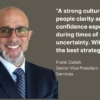
By Frank Dadah
“How to manage a hybrid team.” “Leading in a hybrid work environment.” “Managing virtually.” The “new normal.” These have become the catch phrases of organizational life since the world turned upside down in 2020. But as cliched as the “new normal” sounds, it’s really true. We are in a different place than we were two years ago, a year ago, even six months ago. And managers are still trying to figure out how to get work done and manage their teams who are spread out across the state or even the country.
Remember back before the pandemic when all managing was done in person? That was no piece of cake and we had been doing it for years. Then came COVID and remote working. Suddenly managers had to oversee teams that were completely virtual. They had to learn new communication tools and styles, and create new routines to stay in touch with their people. Now, with people getting “Zoom fatigue,” there’s more phone calls than virtual meetings, so it’s harder to read body language. It’s harder to understand tone and texture, so it’s harder to build meaningful relationships. Certainly, trying to build a team with people who are physically located in different places – some in the office, some virtual, some hybrid – makes managing people more difficult than ever.
Conflicting goals
Many companies want their employees back in the office full-time, and most employees don’t want to give up the flexibility of working remotely. It’s a tug of war. In their recent report, People at Work 2022:A Global Workforce View, the ADP Research Institute found that almost two thirds (64%) of the workforce would consider looking for a new job if they were required to return to the office full time.
More than half (52%) are willing to accept a pay cut – as much as 11% – to guarantee this arrangement.
Some organizations are trying hybrid arrangements, like two days at home, three days in the office. All this flux, however, makes managing exponentially more difficult. With some employees working remotely, some in the office, and some doing a mix, it’s even more challenging to give your time and attention to every one of your direct reports. It’s time (again) to reevaluate how we are managing our people.
Why are people leaving?
In my work with leaders, I hear about their struggles to retain employees in this extremely competitive labor market where there are more job openings than candidates. Many are hiring to replace people who have left the organization, they are not hiring for growth. When asked why their people are leaving, a common response in an exit interview is often a lack of flexibility around work arrangements (in-person vs. remote). But most commonly it’s because the employee’s manager didn’t pay attention to them. Their manager didn’t think of them for projects or promotion opportunities. The employee felt overlooked. And so, the employee started looking elsewhere.
Unconscious Hybrid Bias
Here’s how it often plays out. The employee who is in the office full-time, accessible to their manager, can create a stronger bond than the employee who is working remotely. So, when opportunities arise, the manager often thinks of the person they physically see the most in the office. The in-person employee gets the new projects, is pulled into an important meeting or meets the new client, and the hybrid or virtual employee must compete with that. Managers aren’t doing this on purpose; it’s unconscious. They’re doing it because it’s the path of least resistance. Acknowledging this is half the battle. Managers today must come up with ways to ensure that they’re spreading the wealth throughout the team, whether in-person or virtually.
Use the right tool for the right situation
While this “new normal” has its challenges, you can rely on the skills and tools you already have. It just takes more thought and conscious actions. Here are some ideas that are working for effective leaders.
Be proactive and thoughtful when making decisions. Make sure that you’re not unconsciously biased to the employee who is office-based and forgetting the employee who is working remotely. It could be as simple as putting together a checklist. “The last new client went to Stephanie. Now, I need to look down and give the next one to…,” regardless of whether they’re in the line of sight.
Replicate interactions with office-based employees with your virtual employees. Be conscious of the conversations or interactions you have with people in the office. When you have an interaction with someone in the office, stop for a moment and consider how you can have a similar interaction with your remote employees. Maybe it’s using technology like Slack or team chat. Know that it will not always be organic the way it is in the office. You may need to “force” those little interactions so that people know that you’re there for them. Then they’ll be more apt to reach out to you and then interaction will happen more naturally.
The right tool for the situation. The good news is that we have so much communications technology at our fingertips. The not-so-good news is that we don’t always use it correctly. Texting is great for short, clear messages like, “talk to you at 3.” Email or team chat apps are good for longer messages where you can add more detail or ask questions. But when you need real clarity and clear communication, go to a virtual platform or in-person, if possible. It gives you all the non-verbal cues like tone and body language that you can’t get from written communications. When you need to be sure your message is being received and understood, body language is crucial. Managers have to also proactively give people permission to ask for clarity. Acknowledge that the technology might be getting in the way. Role model that behavior and encourage it among your employees.
Check in more frequently with remote employees. Make sure that you’ve had a quick conversation with everybody, and not just at a high level. Have an authentic, meaningful conversation. Ask probing questions: how are you feeling today? How did that project work out? Are you getting what you need from me and other team members? Encourage remote workers to raise their own visibility. They have a responsibility to “toot their own horn,” letting you and others know what they’re doing and that they’re part of the team.
Many people have been waiting to go back to the “old” way of doing business, pre-pandemic. But all the indicators say that we will probably never go back to the office full-time. Employees have made that determination and employers need to get on board with that. This really is the “new normal.” It’s no longer about getting through the pandemic. We’re there. Now it’s time for leaders to adapt their skills to managing this hybrid workforce.
About MCG Partners
MCG Partners a Greater Boston-based consultancy specializing in executive coaching, leadership development, talent management, and organizational development solutions. We help businesses optimize success through the entire management life-cycle. MCG Partners is also a Predictive Index® (PI®) certified partner.
To learn more about MCG Partners’ services or The Predictive Index®, contact Stephanie Holmgren stephanie.holmgren@mcgpartners.com or at www.mcgpartners.com









